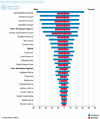Diagnostics and Epidemiology of Colorectal Cancer
- PMID: 27493942
- PMCID: PMC4945785
- DOI: 10.1159/000446488
Diagnostics and Epidemiology of Colorectal Cancer
Abstract
Colorectal cancer is one of the leading causes of cancer-related morbidity and mortality. Main risk factors include advanced age, family history, male sex, and lifestyle factors. Screening can reduce incidence and death from colorectal cancer. Therefore, prevention and early detection are crucial in order to detect and remove pre-neoplastic adenomas and to detect cancers at early stages. Colonoscopy, flexible sigmoidoscopy, and fecal occult blood tests are established tools for screening. Newer fecal immunochemical tests reveal higher sensitivities for advanced adenoma and cancer than guaiac-based hemoccult tests. Molecular stool and blood tests as well as virtual colonoscopy and colon capsule endoscopy are promising new developments so far not established as routine instruments for the prevention and early detection of colorectal cancer. Colonoscopy is the method of choice for the diagnosis of colorectal cancer and for adenoma removal. Prognosis is essentially dependent on the tumor stage at the time of the initial diagnosis. Proper staging based on imaging prior to therapy is a prerequisite. In rectal cancer, local staging is an essential requirement for the identification of appropriate candidates for neoadjuvant therapy.
Keywords: Colon cancer; Colonoscopy; Colorectal cancer; Diagnostics; Screening; Staging.
Figures
References
-
- Ferlay J, Soerjomataram I, Ervik M, Dikshit R, Eser S, Mathers C, Rebelo M, Parkin DM, Forman D, Bray F. GLOBOCAN 2012 v1.0, Cancer Incidence and Mortality Worldwide: IARC CancerBase No. 11. Lyon, France: International Agency for Research on Cancer; 2013. globocan.iarc.fr (accessed January 31, 2016)
-
- Center MM, Jemal A, Ward E. International trends in colorectal cancer incidence rates. Cancer Epidemiol Biomarkers Prev. 2009;18:621–630. - PubMed
-
- Robert Koch-Institut . Krebs in Deutschland 2011/2012. ed 10. Berlin: Robert Koch-Institut; www.krebsdaten.de (accessed January 31, 2016)
-
- Platz EA, Willett WC, Colditz GA, Rimm EB, Spiegelman D, Giovannucci E. Proportion of colon cancer risk that might be preventable in a cohort of middle-aged US men. Cancer Causes Control. 2000;11:579–588. - PubMed
-
- Nguyen SP, Bent S, Chen YH, Terdiman JP. Gender as a risk factor for advanced neoplasia and colorectal cancer: a systematic review and meta-analysis. Clin Gastroenterol Hepatol. 2009;7:676–681. - PubMed
Publication types
LinkOut - more resources
Full Text Sources
Other Literature Sources


